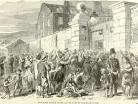Gothic Architecture: Timeline
Created by Paige Adams on Mon, 04/12/2021 - 17:42
Part of Group:
Gothic architecture dates back to 1144 AD, when the first Gothic church was built, the Basilica of Saint Denis. Most of the first Gothic structures were built in Ile-de-France, close to Paris. The Saint Denis served as a model for Gothic architecture. Though the term ‘Gothic’ is derived from ‘Goth’ which described a barbaric tribe in Europe between the fifth to eighth century. The Romanesque architecture started before Gothic in 800 AD. It wasn’t until the 11th century did Gothic architecture begin to unravel. Starting from ribbed vaulting, pointed arches, and flying buttresses that were then added to cathedrals to make the buildings more majestic. It was a change from darkly lit churches, to stained glass windows with geometric and reticulated windows. Other key elements included pinnacles, window traceries, and mullions horizontal bars used for decoration. During the high of the Gothic Era during the 13th century, it was known as 'Rayonnant Gothic.' Rayonnant is defined as 'radiant.' As during this time, Gothic architectural styles were exaggerated into elaborate decorations. In the Late Gothic Era, otherwise known as "Flamboyant Gothic" Gothic decorations were even more elaborate and decorative, adding new features such as, an arched window, stone pinnacles, and sculptures with floral patterns. Gothic architecture was popular from the 1100’s to the 1600’s. During the Romantic Era, this type of architecture was revived, along with the renewal of medieval styles. It was used for its deemed romantic qualities, drawn towards decoration and ornamentation. By the 1820’s buildings were constructed in Gothic style throughout England.
Cited Sources:
Gothic Revival | architectural style | Britannica
Gothic Architecture: Key Elements of the Style (invaluable.com)
Timeline
Chronological table
| Date | Event | Created by | Associated Places | |
|---|---|---|---|---|
| circa. 1300 to circa. 1400 |
Rayonnant GothicA shift away from high Gothic to spatial unity. The addition of larger windows and more light. |
Paige Adams | ||
| circa. 1400 to circa. 1600 |
Flamboyant GothicA form of late Gothic Architecture during the end of the 14th century. Ornamental ribs are added to vaults, along with window traceries, followed by tall-pointed arches. There was also repetition in decorative elements. |
Paige Adams | ||
| 1845 to 1852 |
Irish Potato FamineIn Ireland, a potato blight infected a massive portion of the potatoes grown in Ireland. Potatoes were the primary source of sustenance and there wasn't much diversity in the potato's genetics, so they all were affected the same. The people of Ireland starved for over 4 years before they were able to gain a stable foothold on the amount of food that was needed. 20-25% of the population died from starvation and emigrated to other places to start a new life. Ireland would undergo massive changes politically, demographically, and culturally. |
Aidan Pellegrino |

